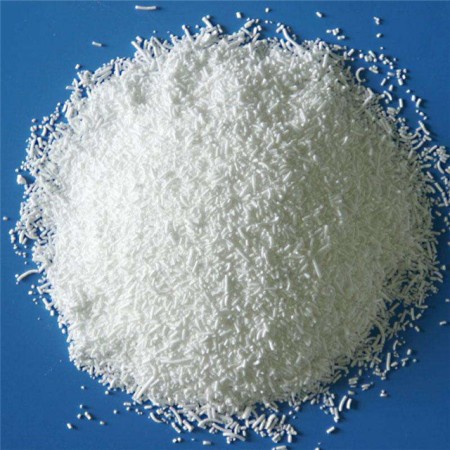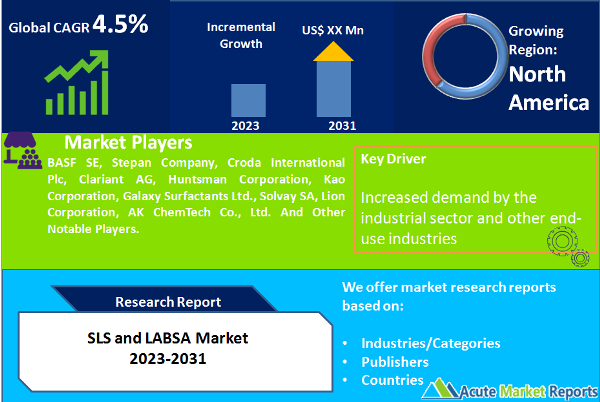
The SLS (Sodium Lauryl Sulfate) and LABSA (Linear Alkyl Benzene Sulfonic Acid) markets are important segments of the global surfactant industry. The SLS and LABSA market is expected to grow at a CAGR of 4.5% during the forecast period of 2025 to 2033. Surfactants are widely used in various applications, such as personal care products, detergents, industrial and institutional cleaning, agriculture, and oilfield chemicals, among others. The SLS market is expected to grow at a moderate pace due to the increasing demand for personal care products and household cleaners. SLS is a commonly used surfactant in applications such as shampoos, body washes, toothpaste, and dishwashing detergents. The growing awareness of personal hygiene and cleanliness, along with the rising disposable income of consumers in developing countries, is driving the demand for SLS in the personal care and household cleaning segments. On the other hand, the LABSA market is expected to grow steadily due to the demand for industrial and institutional cleaning products. LABSA is an important ingredient in formulations of detergents used in industries, hotels, hospitals, and other institutions. The growth of the industrial and institutional cleaning segment, along with the increasing emphasis on cleanliness and hygiene in commercial spaces, is driving the demand for LABSA.

Growing Demand for Personal Care and Household Cleaning Products
The increasing consumer awareness of personal hygiene and cleanliness, along with the rising disposable income of consumers, is driving the demand for personal care and household cleaning products. SLS is a widely used surfactant in applications such as shampoos, body washes, toothpaste, and dishwashing detergents, while LABSA is used in formulations of household cleaners. The global market for personal care and household cleaning products is expected to reach USD 535 billion by 2028, rising at a CAGR of 5.2% from 2025 to 2028. This indicates a significant demand for personal care and household cleaning products, which in turn drives the demand for SLS and LABSA.
Increasing Emphasis on Industrial and Institutional Cleaning
The industrial and institutional cleaning segment, including industries, hotels, hospitals, and other institutions, is placing a growing emphasis on cleanliness and hygiene. LABSA is a key ingredient in formulations of detergents used in these sectors, driving the demand for LABSA. The global market for industrial and institutional cleaning chemicals is projected to reach USD 68 billion by 2027, growing at a CAGR of 4.8% between 2025 and 2027. This reflects the increasing demand for industrial and institutional cleaning products, which is driving the demand for LABSA.
Expansion of the Asia-Pacific Market
Asia-Pacific is a key market for SLS and LABSA, driven by factors such as population growth, urbanization, and increasing consumer spending on personal care and cleaning products. Rapid industrialization in the region is also fueling the demand for LABSA in industrial and institutional cleaning applications. The significant growth potential of the Asia-Pacific market for SLS and LABSA is supported by factors such as population growth, urbanization, and increasing consumer spending. The growing demand for personal care and household cleaning products, increasing emphasis on industrial and institutional cleaning, and expansion of the Asia-Pacific market are three key drivers for the SLS and LABSA markets. These factors are expected to contribute to the growth of the SLS and LABSA markets in the foreseeable future.
Stringent Environmental Regulations and Growing Awareness of Sustainability
The SLS and LABSA markets face the challenge of stringent environmental regulations and increasing awareness of sustainability among consumers and industries. There is a growing concern about the environmental impact of surfactants, including SLS and LABSA, as they may contribute to water pollution, aquatic toxicity, and other environmental issues. This has led to the implementation of regulations and standards to limit the use of certain surfactants in various applications. For instance, in the European Union, the use of SLS in cosmetic products is regulated under the Cosmetic Regulation (EC) No 1223/2009, which sets limits on the concentration of SLS in cosmetic formulations. Similarly, various countries and regions have implemented regulations and guidelines to restrict the use of surfactants, including LABSA, in industrial and household products due to their potential environmental impact. Furthermore, there is growing awareness among consumers and industries about sustainability, and the demand for environmentally friendly and sustainable alternatives to traditional surfactants, including SLS and LABSA, is increasing. This can pose a restraint on the growth of the SLS and LABSA markets as manufacturers may need to invest in research and development to develop and adopt sustainable surfactant alternatives.
LABSA Dominating the Markey by Product Type
Sodium Lauryl Sulfate (SLS) and Linear Alkylbenzene Sulfonic Acid (LABSA) are two commonly used surfactants in various applications. The LABSA market accounted for the highest revenue share in 2024 and is witnessing a trend towards increasing demand for LABSA in liquid form, as it offers better solubility and ease of handling compared to the powder form. Liquid LABSA is widely used in industrial and institutional cleaning applications due to its excellent detergency and emulsifying properties. The SLS market is expected to witness the highest CAGR of 4.5% during the forecast period of 2025 to 2033. The SLS market is witnessing a trend towards increasing demand for SLS in liquid form, as it offers better solubility and ease of handling compared to powder form. Liquid SLS is widely used in applications such as shampoos, body washes, and toothpaste due to its excellent foaming and cleansing properties.
The Household Cleaning Segment Dominates the Market by Application
Within the end-user segment, the household cleaning segment held the highest revenue share in 2024. The applications within this segment include detergents used in household cleaning, laundry detergents, and dishwashing detergents. The increasing demand for household cleaning products and detergents is driving the demand for SLS and LABSA in this segment. The highest CAGR segment within the application segment is projected to be the personal care segment during the forecast period of 2025 to 2033. This segment includes shampoos, body washes, toothpaste, and other personal care products. The growing consumer focus on personal hygiene, grooming, and skincare is expected to drive the demand for SLS and LABSA in this segment.
North America Dominates the Revenues While APAC Promises Significant Opportunities
In terms of CAGR, the Asia Pacific region is projected to have the highest growth rate during the forecast period, followed by North America and Europe. However, in terms of revenue percentage, North America and Europe are expected to hold a significant share of the market due to their mature markets and high consumption of cleaning and personal care products. The Asia Pacific region has witnessed rapid industrialization and urbanization, resulting in increased demand for cleaning and personal care products. China, India, and Southeast Asian countries are expected to drive the demand for SLS and LABSA in this region, owing to the growing population, rising disposable incomes, and changing consumer preferences towards personal care and cleanliness. The North American region is another significant market for SLS and LABSA, driven by the demand for household cleaning products, industrial and institutional cleaning, and personal care products. The region has a mature market for cleaning and personal care products, with a high consumer preference for premium and specialized products. The demand for eco-friendly and natural cleaning and personal care products is also driving the adoption of SLS and LABSA in this region.
Focus on R&D to Enhance Market Shares Among Key Competitors
SLS and LABSA market is highly competitive. Companies operating in the SLS and LABSA market are investing significantly in R&D activities to develop innovative and sustainable solutions. There is a growing emphasis on developing eco-friendly and biodegradable surfactants to meet the increasing consumer demand for sustainable and environmentally friendly cleaning and personal care products. Leading players in the SLS and LABSA market are expanding their product portfolios to cater to a wide range of applications and customer requirements. They are continuously introducing new variants of SLS and LABSA with different properties, functionalities, and performance characteristics to cater to various industries such as household cleaning, industrial and institutional cleaning, personal care, and others. Key players in this market include BASF SE, Stepan Company, Croda International Plc, Clariant AG, Huntsman Corporation, Kao Corporation, Galaxy Surfactants Ltd., Solvay SA, Lion Corporation, AK ChemTech Co., Ltd., And Other Notable Players. These companies are actively engaged in developing new products, technologies, and production processes to meet the changing needs of customers and comply with environmental regulations.
Historical & Forecast Period
This study report represents analysis of each segment from 2023 to 2033 considering 2024 as the base year. Compounded Annual Growth Rate (CAGR) for each of the respective segments estimated for the forecast period of 2025 to 2033.
The current report comprises of quantitative market estimations for each micro market for every geographical region and qualitative market analysis such as micro and macro environment analysis, market trends, competitive intelligence, segment analysis, porters five force model, top winning strategies, top investment markets, emerging trends and technological analysis, case studies, strategic conclusions and recommendations and other key market insights.
Research Methodology
The complete research study was conducted in three phases, namely: secondary research, primary research, and expert panel review. key data point that enables the estimation of SLS and LABSA market are as follows:
Market forecast was performed through proprietary software that analyzes various qualitative and quantitative factors. Growth rate and CAGR were estimated through intensive secondary and primary research. Data triangulation across various data points provides accuracy across various analyzed market segments in the report. Application of both top down and bottom-up approach for validation of market estimation assures logical, methodical and mathematical consistency of the quantitative data.
| ATTRIBUTE | DETAILS |
|---|---|
| Research Period | 2023-2033 |
| Base Year | 2024 |
| Forecast Period | 2025-2033 |
| Historical Year | 2023 |
| Unit | USD Million |
| Segmentation | |
Type
| |
Function
| |
End-use
| |
|
Region Segment (2023-2033; US$ Million)
|
Key questions answered in this report